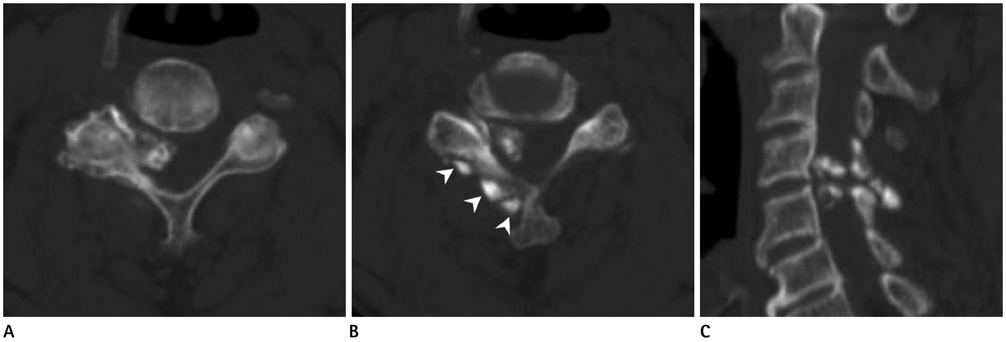J Korean Soc Radiol.
2014 May;70(5):379-383. 10.3348/jksr.2014.70.5.379.
Synovial Osteochondromatosis of the Cervical Spine: A Case Report
- Affiliations
-
- 1Department of Radiology, Seoul National University Bundang Hospital, Seongnam, Korea. joonwoo2@gmail.com
- 2Department of Orthopedic Surgery, Seoul National University Bundang Hospital, Seongnam, Korea.
- 3Department of Pathology, Seoul National University Bundang Hospital, Seongnam, Korea.
- KMID: 1941786
- DOI: http://doi.org/10.3348/jksr.2014.70.5.379
Abstract
- Synovial osteochondromatosis is a rare, benign condition characterized by formation of cartilaginous nodules within the synovium. It rarely occurs at cervical spine, and only six cases have been previously reported in the English literature. We describe another case of synovial osteochondromatosis in the cervical spine in a 77-year-old man who presented with compressive myelopathy. Here we briefly review the literature and discuss the differential diagnosis based on CT and MR findings.
MeSH Terms
Figure
Reference
-
1. Murphey MD, Vidal JA, Fanburg-Smith JC, Gajewski DA. Imaging of synovial chondromatosis with radiologic-pathologic correlation. Radiographics. 2007; 27:1465–1488.2. Fandburg-Smith J. Cartilage and bone forming tumors and tumor-like lesions. In : Miettinen M, editor. Diagnostic Soft Tissue Pathology. New York: Churchill Livingstone;2003. p. 405–411.3. Villacin AB, Brigham LN, Bullough PG. Primary and secondary synovial chondrometaplasia: histopathologic and clinicoradiologic differences. Hum Pathol. 1979; 10:439–451.4. Moody P, Bui MM, Vrionis F, Setzer M, Rojiani AM. Synovial chondromatosis of spine: case report and review of the literature. Ann Clin Lab Sci. 2010; 40:71–74.5. Kyriakos M, Totty WG, Riew KD. Synovial chondromatosis in a facet joint of a cervical vertebra. Spine (Phila Pa 1976). 2000; 25:635–640.6. Greenlee JD, Ghodsi A, Baumbach GL, VanGilder JC. Synovial chondromatosis of the cervical spine. Case illustration. J Neurosurg. 2002; 97:1 Suppl. 150.7. Gallia GL, Weiss N, Campbell JN, McCarthy EF, Tufaro AP, Gokaslan ZL. Vertebral synovial chondromatosis. Report of two cases and review of the literature. J Neurosurg Spine. 2004; 1:211–218.8. Chiba S, Koge N, Oda M, Yamauchi R, Imai T, Matsumoto H, et al. Synovial chondromatosis presenting with cervical radiculopathy: a case report. Spine (Phila Pa 1976). 2003; 28:E396–E400.9. Dharmadhikari R, Dildey P, Hide IG. A rare cause of spinal cord compression: imaging appearances of gout of the cervical spine. Skeletal Radiol. 2006; 35:942–945.10. Feydy A, Lioté F, Carlier R, Chevrot A, Drapé JL. Cervical spine and crystal-associated diseases: imaging findings. Eur Radiol. 2006; 16:459–468.11. Kramer J, Recht M, Deely DM, Schweitzer M, Pathria MN, Gentili A, et al. MR appearance of idiopathic synovial osteochondromatosis. J Comput Assist Tomogr. 1993; 17:772–776.12. Motamedi K, Murphey MD, Fetsch JF, Furlong MA, Vinh TN, Laskin WB, et al. Villonodular synovitis (PVNS) of the spine. Skeletal Radiol. 2005; 34:185–195.
- Full Text Links
- Actions
-
Cited
- CITED
-
- Close
- Share
- Similar articles
-
- Primary Synovial Osteochondromatosis: A case report
- Synovial Osteochondromatosis of the Subtalar Joint in an Adolescent Baseball Player
- Brown-Sequard Syndrome Caused by a Cervical Synovial Cyst
- A Case of Cervical Synovial Cyst Causing Myelopathy
- Regrowing Synovial Chondromatosis in a Cervical Facet Joint with Radiculopathy




